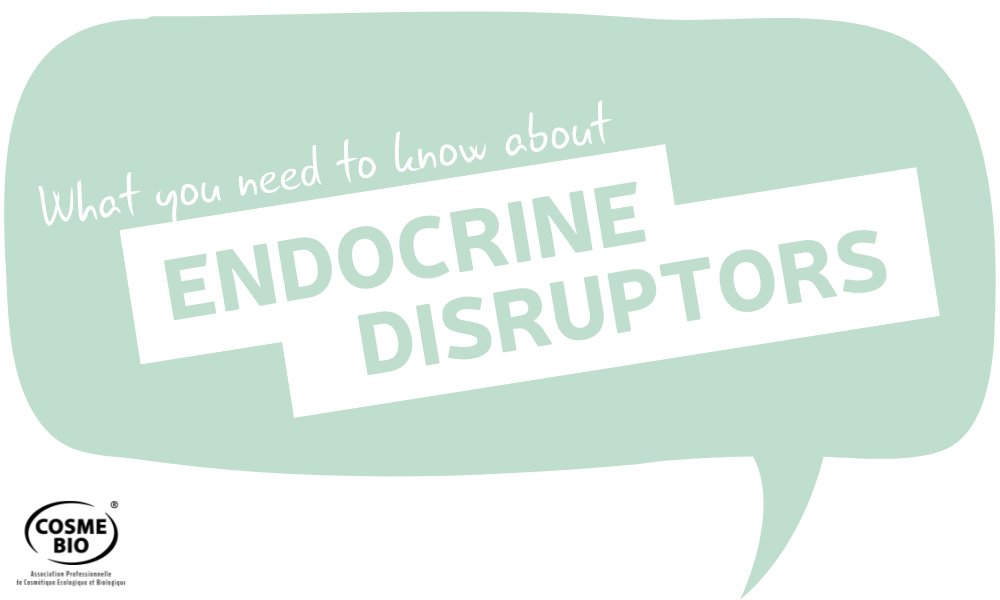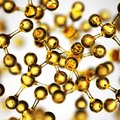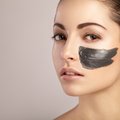For several years now, endocrine disruptors, a quite controversial subject are more and more frequently mentioned in the news. From food to packaging to even our cosmetics, endocrine disrupctors are suspected to be everywhere.
That's why the members of the Technical Commission of the Cosmébio Association put together this article. Here you'll get a comprehensive analysis of these substances, which are now a major public health issue.

What's an endocrine disruptor?
Endocrine disruptors are molecules that disrupt the normal functioning of the hormonal system in many species, including humans. These molecules can be of natural origin (e.g., phytoestrogens) or synthetic (e.g., bisphenol A, alkylphenols, phthalates, polychlorinated compounds).
According to the World Health Organization (WHO, 2012): "An endocrine disruptor is a substance or mixture that alters the functions of the endocrine system and thus induces adverse effects in an intact organism, its offspring, or (sub)-populations."
How do endocrine disruptors function?
Our body secretes hormones that enable various essential functions for our health and development (growth, reproduction, development, etc.).
The particularity of these endocrine disruptors is that they disrupt our hormonal system (the hypothalamus, pituitary gland, thyroid, adrenal glands, pancreas, testicles, and ovaries), creating an imbalance that can affect our health (obesity, diabetes, infertility, etc.).
These substances will affect our hormones and organes in 3 different ways :
The mimetic effect:
Endocrine disruptors mimic the action of a natural hormone to take its place.
The blocking effect:
Endocrine disruptors prevent the natural hormone from acting by binding to the receptors with which they usually interact.
The disrupting effect:
Endocrine disruptors modify the effects of a hormone or its circulation in the body.
Why are endocrine disruptors dangerous?
Endocrine disruptors have characteristics that make them difficult to regulate:
- Studies have shown that even at very low doses, they can be harmful to health. Similarly, they may exhibit a toxic effect that is not proportional to the concentration: some may be more toxic at low doses than at high doses.
- Its difficult to understand their cocktail effect: exposure to a mixture of endocrine disruptors could have a different effect than exposure to a particular substance alone. (Their interactions can either add up, reinforce one another, or inhibit each other).
- Our sensitivity to endocrine disruptors may vary depending on the life stage (prenatal period, childhood, prepuberty, breastfeeding women, etc.).
- Effects on offspring can manifest over several generations.

Where do endocrine disruptors come from?
We are surrounded daily by endocrine disruptors: they are found in water, in the air, in our food and even in household products that we buy.
How are we exposed to endocrine disruptors?
Orally
Food, drinks, medication, lipstick, etc.
By inhalation
Polluted or dusty air, etc.
Through the skin
These substances can pass through the skin's barrier.
Regulatory framework regarding endocrine disruptors
At the European level
To date, there is no specific regulation applicable to endocrine disruptors due to the absence of an official regulatory definition across all European legislation.
However, the European Commission has nevertheless integrated the concept of endocrine disruption into some European regulations to regulate them:
- REACH Regulation (EC No. 1907/2006): Provides that substances with endocrine-disrupting properties and "presenting a level of concern equivalent to CMR substances (carcinogenic, mutagenic, toxic for reproduction)" may be identified as substances of very high concern and thus be included in the list of substances subject to authorization.
- Regulation on biocidal products (EU No. 528/2012) and plant protection products (EU No. 1107/2009) for which regulatory criteria have recently been adopted (respectively Regulation No. 2017/2100 of September 4, 2017, and Commission Regulation 2018/605 of April 19, 2018). These regulations lead to the exclusion of substances evaluated as endocrine disruptors.
- The European CLP Regulation (Classification, Labelling, and Packaging of Substances and Mixtures) plans to include a definition of endocrine disruptors and to create two hazard categories for endocrine disruptors.
- The regulatory definition in cosmetics has not yet been established, but discussions are ongoing.
And in France?
At the national level, France implemented a research strategy on the subject as early as 2014: the SNPE (National Strategy on Endocrine Disruptors) with the goal of reducing our's and the environment's exposure to endocrine disruptors.
In 2018, SNPE2 was announced by the government for the period 2019-2022, with the goal of protecting the us and the environment, notably by establishing a list of substances that may have endocrine-disrupting properties.
In connection with the national strategy, the AGEC law introduced an obligation to inform about the presence of proven or suspected endocrine disruptors in the formulas and packaging of certain categories of products (including cosmetics). This obligation came into force on January 1, 2022, with implementation scheduled for September 2022. The modalities of application are set by decree No. 2021-1110 of August 23, 2021. The ministerial order was published on September 28, 2023 The ministerial order was published on September 28, 2023, to establish the list of proven, presumed, and suspected endocrine disruptors as well as a list of product categories presenting a particular exposure risk.
In this ministerial order, none of the ingredients authorized in organic cosmetics are mentioned. In summary:
128 substances are listed
- 13 substances already prohibited in cosmetics
- 3 substances that could potentially be in non organic cosmetics
- 0 substances authorized by our standard ✊
The list of endocrine disrupting substances
As part of the national strategy, ANSES has identified a list of 906 substances [1] to be evaluated due to their potential endocrine disrupting activity and has developed a methodology for assessing the endocrine-disrupting properties of chemical substances and being able to classify into different catégories: "proven, presumed, suspected". From this list, ANSES has selected 16 substances that it considers a priority for evaluation.
Through the initiative of five national authorities of the European Union (France, Belgium, Denmark, the Netherlands, Sweden), the website edlists.org, launched on June 2, 2020, provided three lists of substances:
o List I
Substances identified as endocrine disruptors at the European Union level
o List II
Substances currently being evaluated for endocrine disruption under EU legislation (included in the CoRAP).
o List III
Substances considered by the national evaluation authority as having endocrine-disrupting properties
Note: Among the substances listed in List II, we find benzyl salicylate and salicylic acid, which can be used in organic cosmetics.
How to limit your exposure to endocrine disruptors
Completely removing endocrine disruptors from our daily lives is impossible, but it is still possible to limit our exposure.
If we focus specifically on cosmetic products, it is preferable to choose organic cosmetics labelled Cosmébio, which significantly reduce our exposure to endocrine disruptors.
In 2016, researchers from the University of Berkeley and the Clinica de Salud del Valle de Salinas in California conducted a study involving about a hundred teenage girls [2]. The study demonstrated that the use of organic cosmetics reduced the amount of synthetic chemical products containing endocrine disruptors found in the body.
Sources :
[1] https://www.anses.fr/fr/system/files/REACH2019SA0179Anx-1.xlsx
[2] Kim G. Harley,Reducing Phthalate, Paraben, and Phenol Exposure from Personal Care Products in Adolescent Girls: Findings from the HERMOSA Intervention Study, 2016



